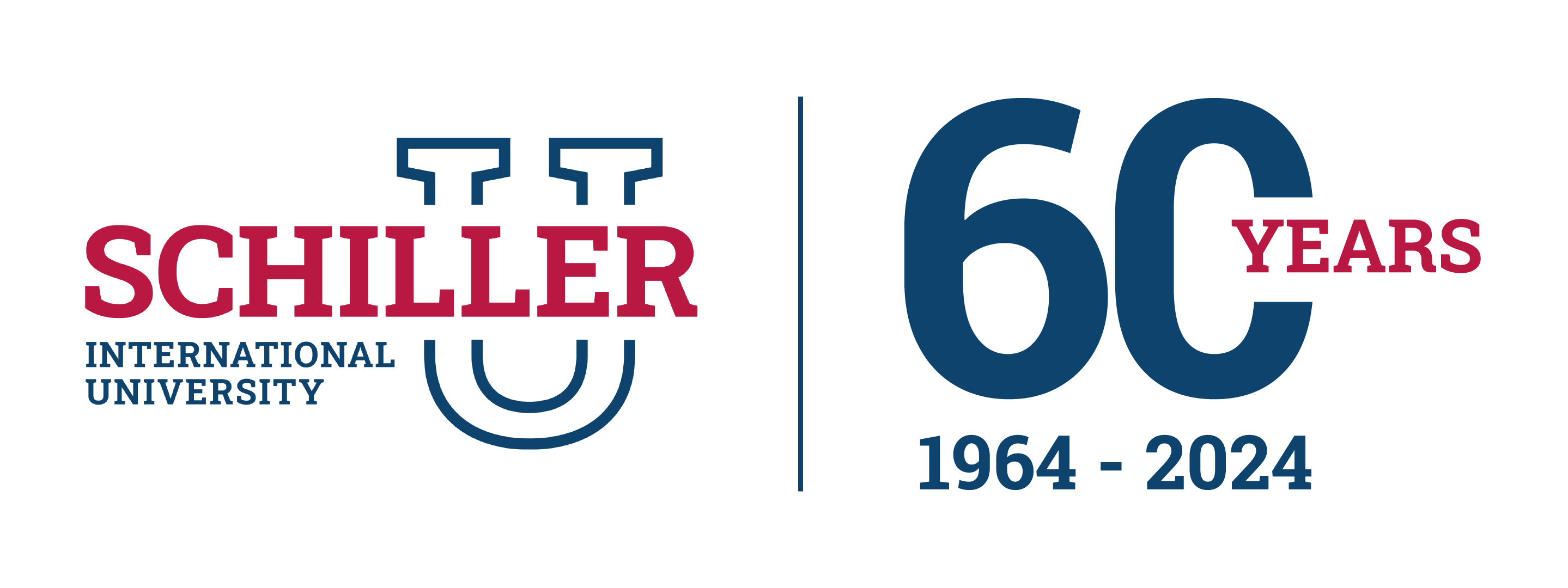The global economy is facing a significant shakeup due to recent Trump Tariffs. When President Donald Trump announced a fresh wave of higher tariffs on $200 billion worth of Chinese imports in April 2025, global financial markets wobbled. President Trump's announcement of reciprocal tariffs has sent ripples through international trade, impacting everything from consumer prices to international relations.
Within days, the S&P 500 fell 3%, and the World Bank warned of a $500 billion drop in worldwide economic activity by 2026. The Dow Jones fell 450 points within hours, and the IMF revised its global growth forecast downward by 0.6% (Bloomberg, 2025).
But what does this mean for the average person, especially international students considering studying in the U.S.? This situation presents both challenges and opportunities for those seeking a global education. Read on to explore the implications of these tariffs, China's response, the global effects, and how Schiller can help you thrive in this new era.
What is a Tariff?
Tariffs are economic grenades. Imagine your favorite imported sneakers suddenly costing 25% more. That’s a tariff—a tax on imported goods to protect domestic producers, pressure other countries or strong-arm trading partners. The tariff is placed on the company that sells the shoes, but that cost gets passed down to the consumer through a higher price tag. Governments use tariffs for various reasons, such as protecting domestic industries, generating revenue, or addressing unfair trade practices. While they can boost local jobs, tariffs often backfire by sparking reciprocal tariffs and inflating prices for consumers and businesses.
President Donald Trump has long been a proponent of tariffs, viewing them as a tool to level the playing field in international trade. The United States has one of the lowest simple average most-favored-nation (MFN) tariff rates in the world at 3.3%, while many key trading partners have significantly higher rates (White House, 2025).
Types of tariffs:
- Ad valorem: Percentage of the item’s value (e.g., 25% on steel).
- Specific: Fixed fee per unit (e.g., $3 per kilogram of aluminum).
- Retaliatory: Response to another country’s trade barriers.
How tariffs work:
- Example 1: The U.S. applies 25% tariffs on Chinese steel → China retaliates with 84% duties on American soybeans.
- Example 2: EU imposes 10% tariffs on U.S. motorcycles → Harley-Davidson shifts production to Thailand.
Tariffs aren’t new, but their scale under the Trump administration is. Since 2025, average U.S. tariff rates have tripled from 3.5% to 12% on targeted imports (CBS News, 2025). For students, this means tomorrow’s business leaders must master trade policy—fast.
A Breakdown of Trump’s Tariff Announcement
On April 2, 2025, President Donald J. Trump announced the implementation of reciprocal tariffs on a wide range of countries. This move, which he dubbed "liberation day," involves imposing tariffs on imports from nations that he believes have been taking advantage of the U.S. for far too long. These tariffs are not uniform; they vary depending on the trade balance between the U.S. and each country. According to the White House, the tariffs will remain in effect until President Trump determines that the threat posed by the trade deficit and underlying nonreciprocal treatment is satisfied, resolved, or mitigated.
Here's the overall information:
Initial Announcement
On April 2, 2025, President Trump declared a national emergency under the International Emergency Economic Powers Act of 1977 (IEEPA) to address what he described as a national emergency posed by large and persistent U.S. goods trade deficits, driven by the absence of reciprocity in trade relationships, currency manipulation, and high value-added taxes (VAT) by other countries. This declaration, detailed in the White House Fact Sheet on Tariff Emergency Declaration, enabled the imposition of reciprocal tariffs to strengthen the U.S. international economic position and protect American workers.
The core policy involves a base tariff of 10% on all imports from every country, effective from April 5, 2025, at 12:01 a.m. EDT. Additionally, higher reciprocal tariffs were set for nations with the largest U.S. trade deficits, notably China, with tariffs reaching up to 145%, effective from April 9, 2025, at 12:01 a.m. EDT. These tariffs are designed to remain in place until the President determines that the trade deficit and nonreciprocal treatment are satisfied, resolved, or mitigated, with the authority to increase tariffs if trading partners retaliate or decrease them if they remedy non-reciprocal arrangements and align on economic and national security interests.
Economic Justifications and Trade Imbalances
The announcement was supported by economic data and studies to justify the tariff measures. A 2024 study cited by the White House suggests that a 10% global tariff could grow the U.S. economy by $728 billion, create 2.8 million jobs, and increase real household incomes by 5.7%. The administration highlighted that U.S. companies pay over $200 billion annually in foreign VAT, and counterfeit goods cost the economy between $225 billion and $600 billion each year, with counterfeit pharmaceuticals linked to $4.4 billion in fentanyl-related issues. The 2024 goods trade deficit exceeded $1.2 trillion, and under the previous administration, agricultural trade turned a surplus into a $49 billion deficit.
To illustrate trade imbalances, the White House provided examples:
|
Product |
U.S. Tariff Rate |
Trading Partner Tariff Rate (Example) |
|
Passenger Vehicles |
2.5% |
EU: 10%, India: 70% |
|
Networking Switches/Routers |
0% |
India: 10–20% |
|
Ethanol |
2.5% |
Brazil: 18%, Indonesia: 30% |
|
Rice |
2.7% |
India: 80%, Malaysia: 40%, Turkey: 31% |
|
Apples |
0% (duty-free) |
Turkey: 60.3%, India: 50% |
The U.S. most-favored-nation (MFN) tariff rate averages 3.3%, compared to higher rates in Brazil (11.2%), China (7.5%), EU (5%), India (17%), and Vietnam (9.4%), underscoring the administration's call for reciprocal treatment.
Exemptions and Special Cases
Certain goods are exempt from these tariffs to mitigate impacts on critical sectors. The exemptions include:
- Articles under 50 USC 1702(b)
- Steel and aluminum, autos, and auto parts already subject to Section 232 tariffs
- Copper, pharmaceuticals, semiconductors, and lumber
- Bullion
- Energy and certain minerals not available in the U.S.
For Canada and Mexico, the tariff structure is aligned with the United States-Mexico-Canada Agreement (USMCA). USMCA-compliant goods face a 0% tariff, while non-USMCA goods are subject to a 25% tariff, and non-USMCA energy and potash face a 10% tariff. If the existing fentanyl and migration IEEPA orders terminate, non-USMCA goods would face a 12% tariff.
Recent Adjustments and Updates
As of April 15, 2025, there have been significant updates to the tariff policies. On April 9, 2025, the Trump administration announced a 90-day pause on additional reciprocal tariffs for most U.S. trade partners, maintaining the base 10% tariff to facilitate negotiations, as reported by Reuters. However, tariffs on Chinese imports remain at up to 145%, reflecting ongoing trade tensions.
Additionally, certain products, including smartphones, computers, and other electronic goods, have been excluded from these tariffs. This exemption, acknowledged by China's Ministry of Commerce as a "small step" towards correcting U.S. trade practices, aims to reduce the immediate impact on consumers and businesses, as noted in a CNN report.
These adjustments indicate a strategic approach by the administration, balancing the enforcement of trade policies with efforts to minimize economic disruptions and encourage international dialogue, as seen in reports of over 75 countries seeking trade talks, according to Reuters.
The Domino Effect: Global Retaliation Escalates
By June 2025, 68 countries had retaliated against U.S. tariffs. Mexico taxed Kentucky bourbon. Canada blocked Wisconsin dairy. But China’s counterstrike was surgical:
- 125% tariffs on Midwest soybeans and pork.
- 84% tariffs on Boeing jets and Ford vehicles (Bloomberg, 2025).
- Rare earth export bans targeting U.S. defense contractors.
The EU tried mediating, but with talks stuck in a 90-day loop, businesses panicked. Apple moved 18% of iPhone production to India, while Tesla accelerated its Berlin gigafactory (BBC, 2025).
How China Retaliated?
China’s response wasn’t just about economics—it was strategic. China has responded to the Trump Tariffs with its own set of retaliatory measures. On April 9, 2025, China slapped retaliatory tariffs of 84% on U.S. goods in response to Trump's tariff announcement. By targeting swing states reliant on farming and manufacturing, they aimed to pressure U.S. policymakers. Iowa soybean farmers, for instance, saw prices plummet to 18% post-retaliation (JPMorgan, 2025). The results?
- Soybean prices crashed 22%, bankrupting 1,200 U.S. farms (JPMorgan, 2025).
- Ford cut 14,000 jobs after losing $3 billion in Chinese sales (CNBC, 2025).
This tit-for-tat approach has intensified the trade tensions between the two economic giants, leading to uncertainty in financial markets and concerns about the future of global trade. J.P. Morgan Research has lowered its estimate for 2025 real GDP growth due to heightened trade policy uncertainty, the effect of existing tariffs and retaliatory measures by foreign trading partners.
Meanwhile, China inked deals with the EU and ASEAN nations, sidestepping U.S. tariffs. For international businesses, this means:
- Supply chains scrambling from China to Vietnam/Mexico.
- Currency markets swinging wildly (yuan down 8% in Q3 2025).
China’s playbook:
- Hit politically sensitive U.S. industries.
- Restrict access to critical minerals.
- Accelerate partnerships with the EU and ASEAN nations.
For international businesses, this means disrupted supply chains and pricier raw materials. Apple recently shifted 15% of its iPhone production to Vietnam to dodge tariffs (CNBC, 2025).
Economic Impact on the U.S.?
The economic impact of the Trump Tariffs is a subject of much debate. Some argue that they will benefit the U.S. economy by encouraging domestic production and reducing the trade deficit. A White House fact sheet cited a 2024 study that found that President Trump's tariffs in his first term "strengthened the U.S. economy" and "led to significant reshoring" in industries like manufacturing and steel production. Another report by the U.S. International Trade Commission found that the tariffs reduced imports from China and stimulated more U.S. production of the tariffed goods, with very minor effects on prices.
However, others fear that the tariffs will harm the U.S. economy by raising prices for consumers and businesses, disrupting supply chains, and provoking retaliatory measures from other countries. The Tax Foundation Research estimates that before accounting for any foreign retaliation, Trump's tariffs will reduce long-run US GDP by 0.8 percent, a loss of 740,000 full-time equivalent jobs, and an average tax increase of $1,280 per household in 2025. Retaliatory tariffs from China, Canada, and the EU, affecting $330 billion of U.S. exports, could further reduce GDP by 0.2%. The Federal Reserve lowered its 2025 growth forecast from 2.1% to 1.7%, reflecting these pressures (Wikipedia) The International Monetary Fund (IMF) estimates that Trump's tariffs could reduce global economic growth by 0.5% through next year.
Proponents argue tariffs protect domestic industries, potentially boosting manufacturing jobs by making imported goods less competitive. However, historical evidence, such as increased consumer costs during the first Trump administration, suggests tariffs often lead to higher prices and reduced economic efficiency (Council on Foreign Relations) The consensus leans toward negative impacts, with higher costs for consumers and potential trade wars harming all parties.
Impact
- Positive: Boost in domestic production for industries protected by tariffs.
- Negative: Increased costs for consumers and businesses reliant on imports.
- Long-term: Potential slowdown in economic growth due to strained trade relations.
Do Tariffs Help or Hurt the U.S. Economy?
It’s complicated.
Potential wins:
- Protected 500,000 manufacturing jobs (White House, 2025).
- Steelworkers: U.S. steel output rose 22%, adding 45,000 jobs (CBS News, 2025).
- Tech startups: “Made in USA” semiconductor firms gained $12 billion in venture funding (HBR, 2025).
Clear losses:
- Families: Average household paid $1,277 extra annually for goods (UChicago, 2025).
- Exporters: U.S. farm exports dropped 14% as China sourced soybeans from Brazil (BBC, 2025).
- Economists estimate prolonged tariffs could cost the U.S. 0.9% GDP growth by 2027 (IMF, 2025).
Impact on International Business?
The Trump Tariffs are creating a climate of uncertainty for international businesses. Companies that rely on global supply chains may face higher costs and logistical challenges. The tariffs could also lead to a decrease in international trade, which would negatively impact on businesses that export goods or services. As nations begin to announce retaliatory measures, the landscape of global trade is poised for upheaval. Oxford Economics notes that if these tariffs remain in place, we can expect a substantial downgrade in growth forecasts for both the US and the global economy.
For international businesses, Trump's tariffs pose significant challenges, disrupting global supply chains and increasing costs. The Harvard Business Review highlights that these tariffs have jolted markets, creating deep uncertainty for business leaders, with executives needing to adapt to primary and secondary macroeconomic effects. The Penn Wharton Budget Model projects long-term GDP reductions up to 8.9% by 2054 under certain scenarios, with middle-income households facing a $58,000 lifetime loss.
Businesses may face higher production costs, reduced profit margins, and deterred investment due to policy uncertainty, as seen in market dives in early 2025 New York Times Analysis. While some domestic industries may benefit from reduced import competition, the overall impact is negative, with potential supply chain diversification to regions like Southeast Asia, though at significant cost and time (Harvard Business Review.)
Global Effects
- Trade Deficit Reduction: Tariffs aim to balance trade but disrupt established supply chains.
- Free Trade Challenges: Higher tariffs undermine principles of free trade.
- Financial Markets: Increased volatility as investors react to shifting trade policies.
Global Business in the Crossfire
Trump tariffs impact international business in three ways:
- Supply chain chaos: Companies face higher costs to reroute production.
- Currency volatility: The yuan and euro fluctuate wildly, complicating investments.
- Regulatory uncertainty: Businesses struggle to plan amid shifting tariff rates.
But chaos breeds opportunity. Vietnam’s exports to the U.S. surged 37%, while Mexico became the top U.S. trading partner in 2025 (JPMorgan, 2025).
Smaller nations like Vietnam and Bangladesh benefit as companies flee China. But for students, this turbulence means employers now crave pros who grasp international economics and crisis management.
How Schiller Prepares Students to Tackle Such Situations?
Schiller International University, with its focus on global education, experiential learning, project-based learning, soft skills, critical thinking, and multicultural environment, offers programs tailored for international students facing these economic shifts to develop a deep understanding of the world's complexities. The MBA in International Business covers international trade, global marketing, and strategic management, using case studies on trade wars to provide practical insights. The BSc in International Business provide a foundation in global operations, including supply chain management and international economics. The MSc in Global Finance focuses on financial markets, risk management, and investment strategies, crucial for navigating market volatility.
With international campuses and a diverse student body, Schiller offers a global learning experience, supported by faculty with real-world expertise and a strong alumni network for career opportunities. These programs equip students to understand and adapt to tariff impacts, ensuring they are prepared for careers in international business and finance amidst economic uncertainty.
The Bottom Line for International Students
As of April 15, 2025, Trump's tariff policies continue to reshape global trade, with significant implications for the U.S. economy and international businesses. While challenges abound, Schiller International University stands ready to support international students through education that fosters deep understanding of the world's complexities, adaptability and strategic thinking. Consider applying to our programs to build a resilient career in a changing world.
Contact us today!

 Apply Now
Apply Now









